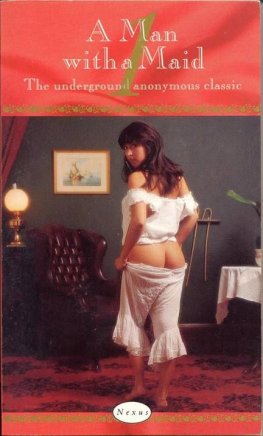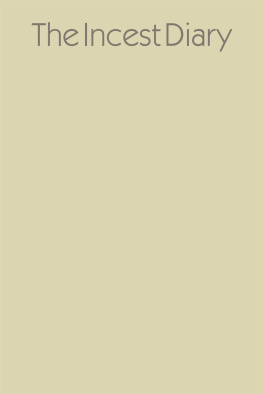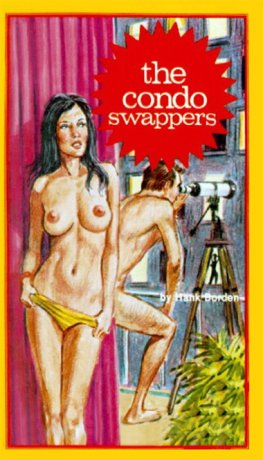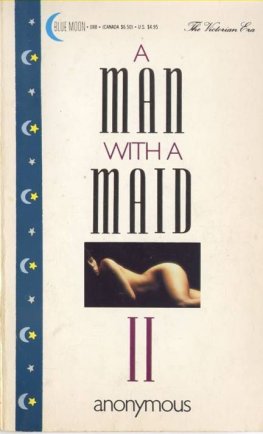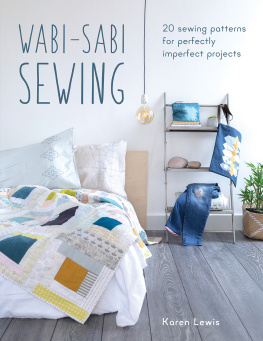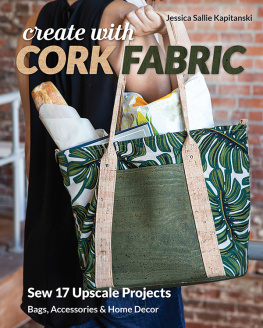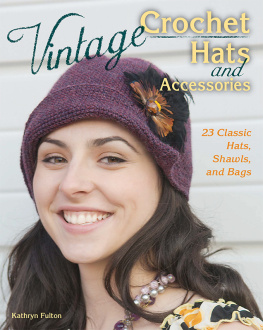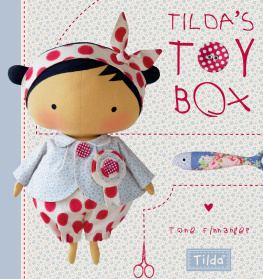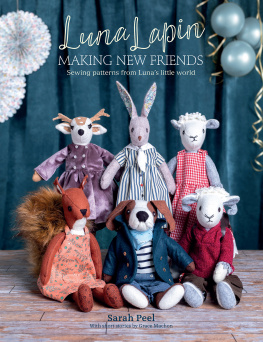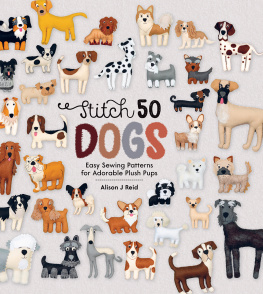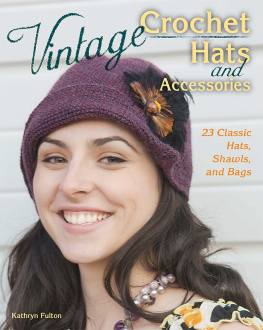Anonymous - A Collection of Vintage Sewing Patterns for the Making of Home Accessories
Here you can read online Anonymous - A Collection of Vintage Sewing Patterns for the Making of Home Accessories full text of the book (entire story) in english for free. Download pdf and epub, get meaning, cover and reviews about this ebook. year: 2016, publisher: Read Books Ltd., genre: Home and family. Description of the work, (preface) as well as reviews are available. Best literature library LitArk.com created for fans of good reading and offers a wide selection of genres:
Romance novel
Science fiction
Adventure
Detective
Science
History
Home and family
Prose
Art
Politics
Computer
Non-fiction
Religion
Business
Children
Humor
Choose a favorite category and find really read worthwhile books. Enjoy immersion in the world of imagination, feel the emotions of the characters or learn something new for yourself, make an fascinating discovery.

- Book:A Collection of Vintage Sewing Patterns for the Making of Home Accessories
- Author:
- Publisher:Read Books Ltd.
- Genre:
- Year:2016
- Rating:5 / 5
- Favourites:Add to favourites
- Your mark:
- 100
- 1
- 2
- 3
- 4
- 5
A Collection of Vintage Sewing Patterns for the Making of Home Accessories: summary, description and annotation
We offer to read an annotation, description, summary or preface (depends on what the author of the book "A Collection of Vintage Sewing Patterns for the Making of Home Accessories" wrote himself). If you haven't found the necessary information about the book — write in the comments, we will try to find it.
A Collection of Vintage Sewing Patterns for the Making of Home Accessories — read online for free the complete book (whole text) full work
Below is the text of the book, divided by pages. System saving the place of the last page read, allows you to conveniently read the book "A Collection of Vintage Sewing Patterns for the Making of Home Accessories" online for free, without having to search again every time where you left off. Put a bookmark, and you can go to the page where you finished reading at any time.
Font size:
Interval:
Bookmark:
Vintage Sewing
Patterns for the
Making of Home
Accessories
Crown Tea Cosy. Royal purple felt, with gold felt decoration, is the scheme used for this original tea cosy. Of the purple felt you will need two pieces 12 by 16 inches, of gold 3-inch wide strips sufficient to make 2 1/2 to 3 yards of trimming. Use any suitable lining the same size as the purple felt, and wadding 10 1/2 by 15 inches. For sewing match the felts with Dewhursts Sylko Machine Twist. The finished cosy measures about 15 inches long and 12 inches deep, including the handle.
First make a paper pattern by ruling paper size 16 by 12 inches into 1-inch squares, then draw in main shape and solid trimming shapes shown on diagram (page 20), which has corresponding squares. Cut out main shape, then cut twice in lining and twice in purple felt. Cut two wadding pieces the same shape, but 1/2 inch smaller round curved edge, and 1 inch smaller at lower edge.
Place each wadding piece in centre of lining and quilt together in diamonds with fairly large stitches. Turn over surplus lining and hem down, then place the two pieces together, linings facing, and overcast round curved edge. Back-stitch the purple pieces together round curved edge, 1/4 inch in, turn out and slip over pad ding; turn up lower edge over padding and hem.

CROWN TEA COSY

Actual-size pattern for the Fleur-de-Lis. Cut four in gold felt and stitch two to front of cosy, two to back.
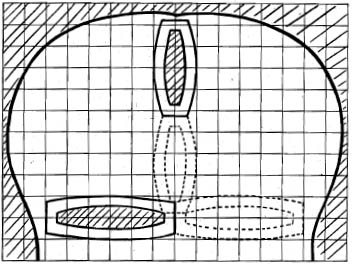
Pattern for Crown Cosy. Each square represents one inch.
For trimming cosy, from paper pattern cut out the two shapes shown by solid lines. Place each pattern on a strip of doubled yellow felt and cut out; repeat this for other side of cosy. For side trimming, place shorter pattern piece on felt strip folded into three; repeat this for other side. Open out strips. Pin the shorter double piece down centre of cosy, then pin longer double piece across lower edge so that centre overlaps end of centre trimming. With matching Machine Twist hem neatly in position round all edges. Take a triple strip and pin it over side edge of cosy, one end level with lower trimming and other end near centre top. Pin other strip over other side edge in same way, then hem both in position. From yellow felt cut out fleur-de-lis four times from actual-size pattern, and stitch on in position seen in photograph.
For handle, cut two 2 1/2-inch circles of yellow, fold each in half lengthways and make a ridge by stitching close to fold; fold again at right angles to first stitching and stitch in same way. Stitch together round outer-edge on right side, inserting wadding just before finishing to make a good fat knob. Stitch firmly to top of cosy.

Soldier-Boy Egg-Cosy. A child can easily make this amusing cosy fashioned entirely from scraps of felt in pink, black, red, yellow and white. For face cut two 3 1/4-inch circles of pink and overcast together three-quarters of the way round; turn out (opening is lower edge). For bearskin cut two black rectangles 3 1/4 by 3 1/2 inches and round off one narrow end to bearskin shape. Overcast together, leaving 3 1/4-inch edges open. Turn out and slip over top half of face; hem in position invisibly. Make collar from two 1/4-inch strips of red cut to shape of chin; stitch on, joining ends; cut out a V at centre front. For chin-strap cut narrow yellow strip and stitch by one edge round face, slipping ends under hat. Stitch small triangle to one side of bearskin for cockadeby varying the colour of this, each member of the family can belong to a different regiment!
For eyes cut two 3/8-inch circles of white and two 1/4-inch circles of black; stitch on face 5/8 inch apart, black on white. For mouth, stitch red oval 1/2 by 3/8 inch just above chin-strap through centre.
Materials: 3/8 yard 36-inch wide Red poplin or sailcloth.
Felts as follows:White 18 12 ins.; Green 8 6 ins.; Red and Blue 4-in. squares; Black 2 ins. square; Yellow 4 2 ins.
Lengths of Black and White stranded cotton for embroidery and matching cottons for applique. Wadding for pad.
Size: 8 12 ins. Diagrams on Page 37.
Draw brown paper pattern of Coffee Cosy outline from plan (each square measures 1 inch). Note: Top shaded portions are trimmed away to give an oval outline.
Draw round pattern 4 times on Red material and cut out 1/2 inch away from outline all round.
Make up: With wrong side of work facing, stitch two pieces together for front of cosy up each side and round shaped edge, stitching 1/2 inch in from edge and leaving lower edge open. Turn right side out.
Stitch remaining two pieces together for back in same way. Cut two pieces of wadding to fit and insert a piece into each of front and back.
Turn in 1/2 inch at lower edge and stitch edges together. With wrong side of work facing, over-sew front and back together up each side and round shaped edge, turn right side out.
Now copy Smiling face onto brown paper pattern, and cut out complete oval face.
Draw round this twice on White felt and cut out on outline.
Now cut up the face to give shapes for eyes, nose, mouth and crescent-shaped collar, and draw round outlines on felts as follows:Eyes on Blue, Pupils on Black, Nose and Mouth on Red, Collar on Green.
Using matching cotton and tiny over-sewing stitches, applique Smiling face, as shown on Plan, as follows:Blue eyes; Black Pupils; Red Nose and Mouth; Green Collar.
Use same patterns for Cross face with the exception of the mouth which is made separately in the shape of an oval.

Humpty Dumpty Coversare fun to make in felt
Draw round pattern pieces on appropriate pieces of felt as before, and applique as on plan.
Mark eyebrows on both faces, and embroider in stem stitch using 3 strands of Black cotton. Cut Yellow felt in half to give 2 pieces, 4 1 ins.
Cut 1/2-inch strip from end of both pieces and stitch round centre of each strip of felt to make 2 Bows.
Stitch a Bow to centre of Collar on both pieces.
Stitch faces in position on front and back of cosy. Draw lines on Red material to represent brick wall, and using 3 strands of White cotton, embroider in straight stitches as shown on stitch diagram.
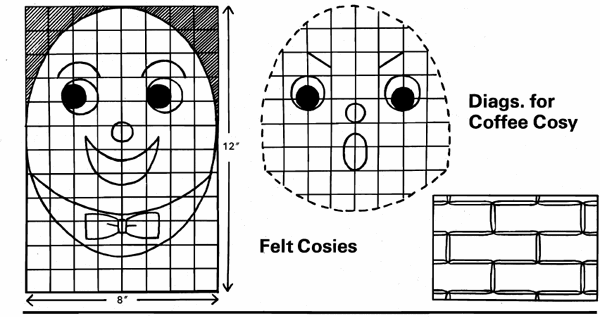
Materials: Piece of Red poplin or sailcloth, 6 18 ins.
Felts as follows:White 8 5 ins.; Green 3 ins. square; Red, Blue and Black 2 1 ins.; Yellow 4 1 ins.
Lengths of Black and White stranded cotton for embroidery and matching cottons for applique. Wadding for pad.
Size: 3 1/2 4 3/4 ins.
Font size:
Interval:
Bookmark:
Similar books «A Collection of Vintage Sewing Patterns for the Making of Home Accessories»
Look at similar books to A Collection of Vintage Sewing Patterns for the Making of Home Accessories. We have selected literature similar in name and meaning in the hope of providing readers with more options to find new, interesting, not yet read works.
Discussion, reviews of the book A Collection of Vintage Sewing Patterns for the Making of Home Accessories and just readers' own opinions. Leave your comments, write what you think about the work, its meaning or the main characters. Specify what exactly you liked and what you didn't like, and why you think so.

